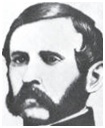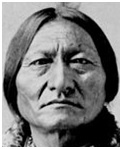|
 |
|
 |
|
|
||
Crazy Horse Leadership
Leader of the Sioux Native Americans in the Great Plains of Dakota, Nebraska and Wyoming. Continually fought against the invading whites, and the government’s order that all Sioux people had to remain on reservations after January 1876. Crazy Horse (pictured right) defeated General George Custer at the Battle of the Little Bighorn (1876).
Why was he a great leader?
1. Servant leader He always put his people before himself. He fought to defend their interests, territory, traditions and the buffalo, which was vital to their survival. The buffalo gave them
When the whites eventually killed off the buffalo, the Native Americans’ way of life died with it.
2. Brilliant tactician and learner He used brilliant decoy tactics to lure Captain Fetterman (pictured right) into an ambush in 1866, killing him and all 80 of his men. At the Battle of Little Bighorn , he learned from previous battles the importance of:
He quickly outflanked Custer and attacked him from an unexpected direction rather than attacking him head-on.
3. Bravery He was famous for his courage, always leading his men into battle and yelling words of encouragement.
4. Integrity He was a man of honour, who stuck to his principles with modesty and humility. When offered tobacco by the American government as a bribe to give up its land, he said, “One does not sell the earth upon which the people walk”.
5. Determination and spirit He was determined to be a great leader, despite personal tragedies (like the death of his daughter from cholera
in 1874) and continual battles against the superior firepower and numbers of the white man. His greatest victories were the Battle of the Rosebud in 1876 and his defeat of General Custer (pictured right) at the Battle of the Little Bighorn soon after. Crazy Horse only surrendered in 1877, when his people were exhausted from fighting and demoralized from dying buffalo and no clothing. He hated surrendering to a people he considered inferior, but he had no choice. Four months later he was killed trying to escape imprisonment after being double-crossed.
6. Spiritual inspiration The Sioux believed their lives were controlled by a sacred spiritual force, shown as visions to certain people (including Crazy Horse and another great Sioux chief, Sitting Bull, pictured right, whose vision foresaw Custer's defeat at the Battle of the Little Bighorn) These visionaries were revered by everybody else as holy and powerful. As a boy, Crazy Horse's first vision showed him riding first into battle as the servant of his people. His father, a holy man, told him that this was his destiny. His many other visions increased people’s respect for him still further.
Key quote on life My lands are where my dead lie buried. |
|
|
||
|
|
||
| Copyright © wisdomtowin.com 2025 All Rights Reserved | ||
|


 Crazy Horse (1841-1877)
Crazy Horse (1841-1877)


